Perfect 500 Rule Prime Rib
Making tender and juicy perfect prime rib roast in the oven is easy using the 500 rule and this Perfect 500 Rule Prime Rib is the best, most detailed recipe you’ll find on the web.
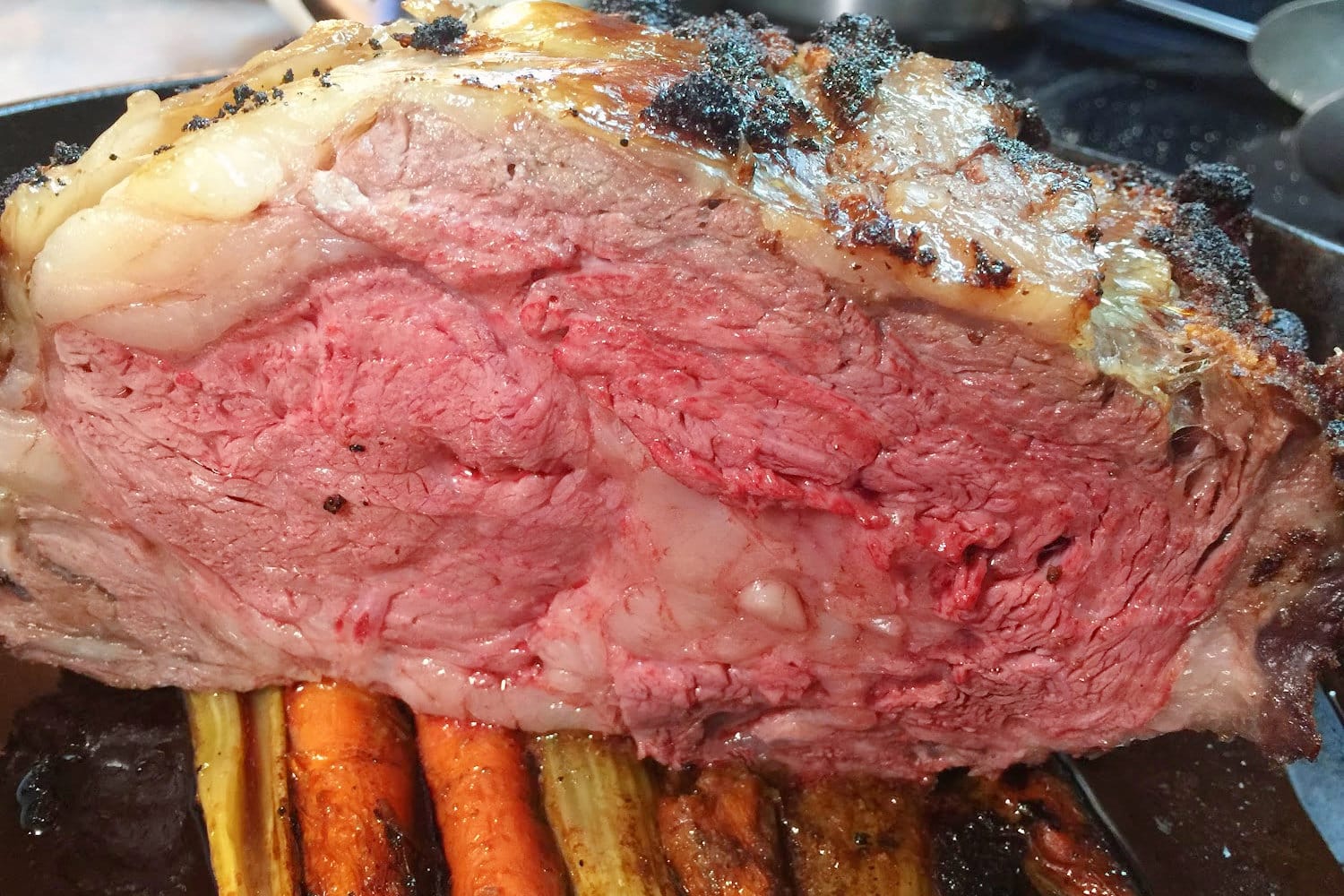
Best Prime Rib Roast Recipe
We love making prime rib roast or roasted beef tenderloin in the oven for Sunday gatherings and Christmas, New Year’s Day, and Easter holiday dinners.
If the words prime rib at home put fear in your heart, you’ve come to the right place!
Just follow my step-by-step directions below….you do not need to be afraid! You can conquer, and I’m here to show you how.
Save this Recipe
Enter your email address and we will send you this recipe to your mailbox for easy reference! Plus, we will send you our latest recipes every week!
I remember first using this no peek 500 degree method to cook a prime rib. I was apprehensive about it.
A prime rib is an expensive hunk of meat. I was worried I’d ruin it, wasting my hard-earned money AND precious time.
If you are brand new at cooking a prime rib roast, read this entire recipe before purchasing or preparing your prime rib. There are a lot of great tips and tricks.
Whenever you can feed a group of people, this prime rib recipe that uses the 500 Degree rule will become your go-to method.
It makes perfect prime rib roast in the oven and creates a holiday tradition that makes special memories for our family and guests.
Oven full during the holidays? I have also made this Prime Rib in a Roaster Oven recipe that is perfect!
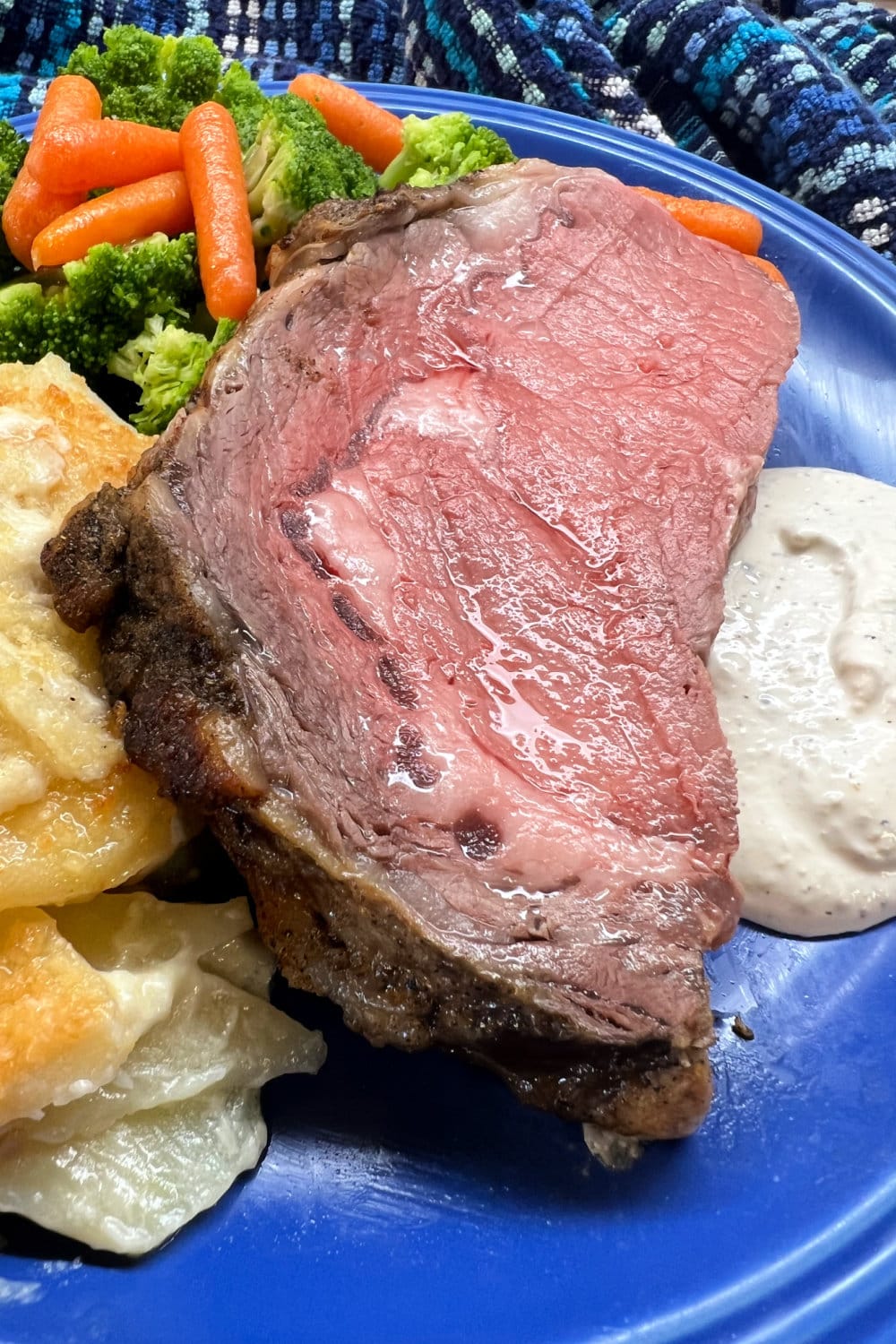
500 Degree Rule No Peek Prime Rib Ingredients
Prime Rib
- 8-10 lb. 4-rib standing rib roast, bones cut off and tied back on by the butcher, room temperature
- Seasonings: granulated garlic (or garlic powder), granulated onion (or onion powder), freshly ground black pepper, seasoned salt (I use Lawry’s Seasoned Salt
Creamy Horseradish Sauce
- Sour cream
- Whipping cream aka heavy cream
- Hot pepper sauce, as desired, aka Tabasco
- Worcestershire sauce
- Prepared horseradish: Be sure to use refrigerated fresh-grated horseradish, not cream-style horseradish found in the condiment section of the grocery store. You’ll usually find prepared horseradish in a glass jar near the meat department.
- Spicy brown mustard: You can substitute Dijon mustard, if preferred
- Red or white wine vinegar
- Garlic cloves: I really prefer the fresh garlic in creamy horseradish sauce,but feel free to substiture garlic powder or granulated garlic if preferred.

Au Jus
- Better Than Bouillon Concentrate, Beef Flavor (or use beef bouillon cubes)
- Soy sauce
- kosher salt and freshly ground black pepper, to taste

How to make prime rib in the oven
4-5 hours prior to cooking the prime rib roast, remove it from refrigeration; unwrap the roast from all packaging.
Whatever you do, please do not skip the step of removing the rib roast from the refrigeration to rest for at least 2 hours before cooking it.
Removing some of the chill from the roast and letting it rest is essential for the success of the closed-oven method for cooking prime rib in this recipe.
Note the exact weight of the roast to better calculate the cooking time.

Combine the granulated garlic, granulated onion, and black pepper with the seasoned salt in a small bowl. Using your fingertips, rub spice blend over every area of the roast.
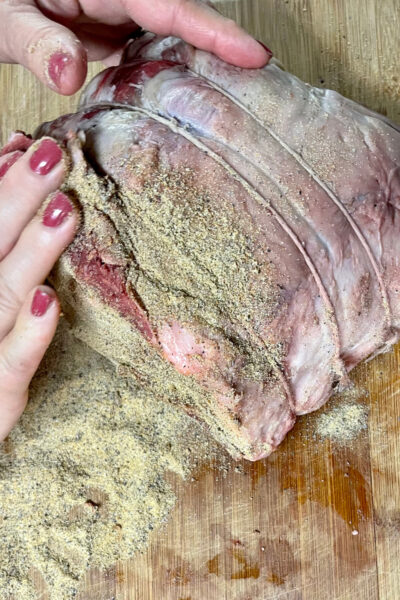
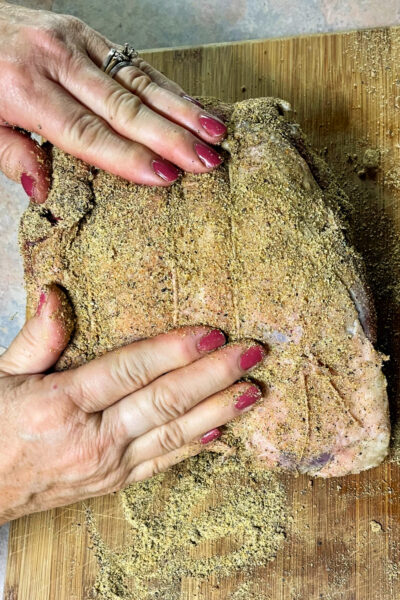
When you are ready to cook the prime rib roast, pre-heat the oven to 500 degrees F., placing your oven rack in the lower third of the oven.
Place the seasoned roast, fat side up, onto a roasting rack in your roasting pan.
If you don’t have a roasting rack, make one by placing whole ribs of celery and whole carrots side-by-side across the bottom of the roasting pan – this works just great.
Instead of a roasting pan, you can always substitute a very large cast iron skillet (depending on the size of your rib roast) or use a rimmed baking sheet.
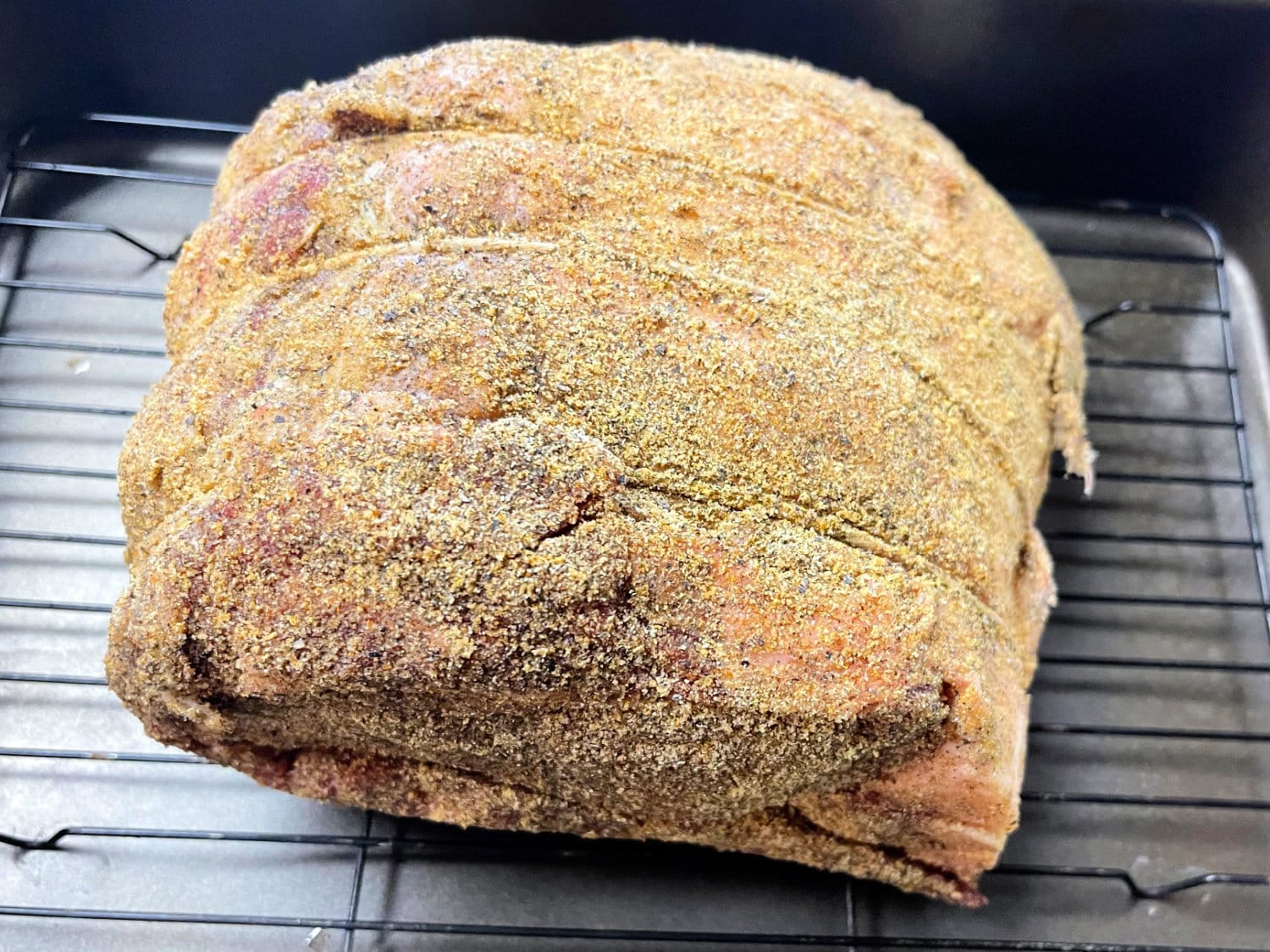
Place the prepared rib roast into the preheated 500 degree F. oven, uncovered, and cook for 6 minutes per pound for medium rare.
When the timer sounds, immediately turn your oven temperature down to the lowest setting, which for most ovens is 170 degrees F.
No matter what, do not open the door at this point. Set your timer for 2 hours at this point.
When the timer sounds at the full 2 hour mark, open the oven door, using an instant-read meat thermometer to check the internal temperature of the meat.
For medium rare prime rib, you’ll want the internal temperature to be 130-135°F.

If your roast temps a bit cooler than 130-135 °F, simply preheat your oven to 375 °F., return the roast to the oven until the internal temp reaches 130-135 °F.
Checking the internal temperature every 10 minutes or so until the prime rib raises a few more degrees to the desired temperature.
Using big forks, lift the prime rib roast from the rib rack and the roasting pan, placing it onto a large cutting board.
Snip the strings that are holding the bone rack to the prime rib roast.

Slice the prime rib into thick slices, placing them onto dinner plates.

Pour a bit of the warm au jus over the prime rib, then add a dollop of horseradish sauce alongside. Serve at once.
If you have a guest who wants their slice of prime rib a little more done than medium-rare, slide their slice into a skillet of simmering broth or au jus for a few seconds.
How to make creamy horseradish sauce
Combine all the sauce ingredients in a small bowl until smooth; store in the fridge until ready to serve.
How to make au jus
Place the water into a skillet and bring to a boil; reduce the heat to low, then add the bouillon concentrate, as well as the soy sauce, and garlic, whisking until well blended. Season to taste with salt and pepper; keep warm.
How long should I cook my prime rib using the 500 degree rule?
Here’s the formula for cooking medium-rare prime rib:
Take the weight of your prime rib roast and multiply it x 6 minutes. For example, a 6 lb. rib eye roast multiplied x 6 minutes = 36 minutes in the oven at 500 degrees F.
Here’s the formula for cooking medium prime rib:
Take the weight of your prime rib and multiply it x 7 minutes. As an example, a 6 lb. roast multiplied x 7 minutes = 42 minutes in the oven at 500 degrees F.
Please Note: I don’t typically recommend that prime rib should be cooked to medium as an internal temperature. Once you’ve over-cooked a piece of meat, there’s no going back.
If you’ve cooked a piece of meat to a medium-rare state, you can always cook it longer to raise the internal temperature to what you prefer.
The 500 Degree Rule Means NO PEEKING
Once the prime rib roast is finished roasting at 500 degrees F., DO NOT OPEN THE OVEN DOOR. Even though you’ll be dying to see what your prime rib looks like now.
Turn your oven to its lowest temperature setting (usually 170 degrees F. for most ovens. Then set your timer FOR TWO HOURS following the initial roasting process at 500 degrees F. This is where the duct tape and signage are essential. You don’t want anybody opening the door, including yourself.
DO NOT open that oven door for ANY reason!
How long to cook prime rib depends on the size of the prime rib roast
The KEY to making sure this no-peek closed-oven-door method works is to know the weight of your roast. Then you can cook it according to the formula above.
When you open up that parcel of prime rib, be sure you keep the label that has the weight!
Stick the label somewhere safe because. You will need it when you get ready to prepare your prime rib.
What is the ideal internal temperature for a medium-rare prime rib?
The internal temperature for a medium-rare prime rib is 130-135 degrees F. at the center of the roast. You will need an instant-read meat thermometer to determine the internal temperature of the prime rib.
Most feel that prime rib should be served medium rare for the best dining experience.
After roasting the rib eye roast, let it continue to rest for exactly two hours inside the closed oven. You will have the most succulent, juicy, amazing prime rib…..perfectly medium-rare and perfectly cooked, all ready to serve and enjoy!
Why Cook Prime Rib Roast in the Oven?
Who wants to stand around grilling steaks when you’ve got special guests to tend to? This recipe will provide you with thick-cut, steak cuts that will be ready all at the same time.
Prime rib roast in the oven is a huge RIB-EYE roast, the same cut that rib-eye steaks are cut from, and it’s magnificent.
What To Consider When Cooking a Prime Rib Roast
There are a few things to consider when purchasing your rib roast to make prime:
- what rib roast to purchase
- how much roast to purchase
- how you’ll be cooking
- how to slice and serve
- what side dishes you’ll need
Common Questions When Making Standing Rib Roast
Is it okay to purchase the prime rib from the meat case at my local grocery store?
Yes! This recipe will still be perfect! The primary difference in a PRIME prime rib (what you would typically purchase from a good butcher shop) and a CHOICE prime rib (what you’ll typically find at your local grocer) is basically this: the amount of marbling within the roast.
Prime rib is a very fatty cut of beef. Many people feel that cooking a CHOICE prime rib from the grocery store is delicious!
I seek out a butcher shop to purchase my standing rib roast to make prime rib
Since I only cook prime rib at the holidays, I have always purchased prime rib from a butcher. I want it to provide the best eating experience available to me and my family.
I want that rich, buttery flavor and texture, plus lots of juiciness, too.
Marbling contributes to the level of flavor and juiciness in the eating experience of the prime rib.
The best grade of rib eye roast will have a lot of marbling. A good butcher shop will know this too.
They can also answer any questions about pricing, how much you need per person, cooking, etc.
A good butcher wants you to be successful cooking and wants you to return as a customer.
Also, tell your butcher the full story so he gets the big picture. Let them know what you’re trying to accomplish. Share how many people you’re serving and that you’re nervous about the prime-rib process if that’s the case.
A butcher can’t help if they don’t have all the details! Butchers are very accustomed to their customers feeling apprehensive when purchasing and cooking their first standing rib roast.

Should I ask the butcher to cut off the bones?
Yes! I know it may sound weird, but hear me out. Once the bones are cut from the prime rib roast, ask the butcher to tie the bones back onto the roast.
Cooking with the bones will give it a lot of additional flavor due to the bone marrow.
Snip the strings when the prime rib roast is cooked and ready to slice. Lift the roast right off the rack of bones and onto your cutting board. You can now very easily slice that prime rib roast.
If I purchase a CHOICE prime rib roast instead of a PRIME prime rib roast, do I need to cook it differently?
If you purchase choice prime rib from the grocery store, it will most likely be boneless and cook much more quickly than a prime, bone-in prime rib.
The choice cut of the prime rib has less marbling.
When cooking choice prime rib, opt to undercook it since there is less marbling in the meat. You can always cook a prime rib more (longer), but once it’s overcooked, you can’t go back!
Why are there so many names for prime rib?
It can be very confusing when purchasing a prime rib roast for the first time. There are many different names for the same cut of beef, including:
- rib roast
- rib eye roast
- standing rib roast
- eye of rib roast
- prime rib roast
Your butcher can help you understand the names but know they are all the same roast.
Choice prime rib from a grocery store has prominent prime rib labeling to help customers easily identify the cut.
How MUCH prime rib should I purchase for my gathering?
Most butchers recommend purchasing one pound of boneless rib eye roast for each person at the meal.
Prime rib roasts are sold two ways: bone-in or boneless. Boneless rib eye roasts are typically cheaper and easier to manage your first time. A bone-in rib eye roast provides more flavor and a juicer, richer eating experience.
Each rib of a bone-in rib eye roast has up to 2 lbs. of meat. Therefore, if you serve prime rib to a group of 8 people, you’d need a 4-rib roast.
For a bone-in rib eye roast for prime rib never buy a roast with less than 3 ribs.
When cooking prime rib to serve several people, is it better to cook one large prime rib roast or two smaller rib roasts instead?
I’m so glad you asked – this is a great question! Let’s say you’re feeding 10 people. Instead of getting one large 5-bone prime rib roast, opt for two 3-bone rib roasts, instead.
When using this specific cooking method (the closed-oven method), I’ve found that two smaller rib roasts work best.
The 500 degree method doesn’t work well with prime rib roasts smaller than 2 ribs. They easily overcook.
Is it true that you shouldn’t cook prime rib while it’s still cold from being in refrigeration? Why?
YES! This is called BEAUTY REST for your beef, and it is so very essential. Cooking any meat without letting it rest at room temperature is not a good idea, in my opinion.
When a hunk of meat has been in refrigeration, all the juices and fats are coagulated at the very center.
Resting at room temperature allows juices and fats to move from the center to the outer areas of the roast.
During this, the roast and all of its protein fibers can relax in preparation for the cooking process.
Adequate rest ensures that your prime rib roast can cook much more evenly and consistently. This provides a far better eating experience later. Just what we long for!!
Don’t be afraid to remove your prime rib roast from refrigeration at least 4-5 hours before the cooking process.
Is there a special technique for cooking a prime rib with a crust and nicely charred exterior?
Uncover your rib eye roast the night before and let it sit naked in the fridge. This will really help with that beautiful browning we long for.
Where should I insert an instant-read meat thermometer into the prime rib to take the correct internal temperature?
Insert the thermometer into the center of the roast. Go straight in from the side where the meat is the thickest.
Coming in from the side helps ensure you don’t touch any bones or the bottom of the roasting pan. This can give a false temperature reading.
Watch the dial once you insert the instant-read meat thermometer into the prime rib. Once the temperature stops rising, that is the internal temperature of the roast. This will take 30-60 seconds.
And does the prime rib need beauty rest AFTER it’s finished cooking as well?
YES!!! And this recipe makes it super easy – you won’t even have a chance to do otherwise!
What is the best way to slice and serve my prime rib roast?
If you have a standing rib roast that’s had the bones removed and then tied back on, cut the strings while it’s still in the roasting pan.
Lift the roast up and off the bone rack that it’s resting on. Place the prime rib onto a large cutting board where you have ample room for slicing.
Cut the prime rib into thick slices and place it onto dinner plates.
Pour a bit of the warm au jus over each slice and add a dollop of the creamy horseradish on the side. Ta-dah!!!
Medium Well Done or Well Done Prime Rib Tips
You may have THAT ONE GUEST who will insist that “they only eat their prime rib WELL DONE.” Ewwww….but whatever, right??
If you have guests who think that medium-rare prime rib slice isn’t cooked enough, here’s a hack. Keep a skillet of simmering beef broth on your stove top!
Simply slide their slice of prime rib slice into the simmering broth and let it cook for a few seconds. The prime rib slice will cook very quickly and you can then remove it from the broth to their plate. It will be moist and delicious. Just what they want….and everybody’s happy!!
Best Prime Rib Rub
Seasoned Salt, Granulated Garlic, Granulated Onion, and Freshly Ground Black Pepper make the crust of your standing rib roast. You’ll season the exterior of your standing prime rib roast with and use it for your prime rib rub. This makes the exterior nice and flavorful as you roast it in the oven, then enjoy it for dinner.
The Best Creamy Horseradish Sauce
Prime rib just isn’t prime rib if there’s no creamy horseradish sauce to accompany it. The main ingredient in horseradish sauce is sour cream, but the most important ingredient is the horseradish, hands down.
You’ll need what’s called prepared horseradish, which is freshly grated horseradish root. Don’t make the mistake of getting cream-style horseradish that’s located in the condiment aisle of the grocery store.
The remaining ingredients needed for making horseradish sauce are things you’ll likely already have on hand including:
- whipping cream
- spicy brown mustard
- Worcestershire sauce
- red or white wine vinegar
- crushed garlic
- salt
- pepper
You can make the horseradish sauce ahead of time and store it in the fridge until ready to serve.

Au Jus Sauce for Ribeye Roast
Au jus (pronounced ah-zhoo) refers to thickened juices from a roast or other meat. The term translates literally to “with the juice.”
Traditional prime roast has always been served with an au jus. Typically it is drizzled over an individual slab of prime rib, accompanied by a dollop of horseradish sauce.
Many people use a basic simmering beef broth as their au jus to keep it simple.
Do I have to serve the prime rib with the au jus or can I skip that?
You can skip the au jus, if preferred. If your prime rib is served medium-rare, it will be super-juicy and tender. Nobody will miss au jus too much.
And yes, many people substitute plain beef broth instead of homemade au jus – it’s acceptable.
Keep a simmering pan of broth or au just on the stove. This will give you the option of cooking a slice of prime for somebody who wants it done more. There’s always THAT ONE, as we discussed above.
But please don’t ever skip the creamy horseradish sauce – this is just essential to prime rib!
Side dishes to serve with prime rib
Everybody has a preference for their favorite side dishes for prime rib roast in the oven. Here are a few of my family’s favorite side dishes:
- Milion Dollar Mashed Potaotes
- Creamy Mashed Potatoes Supreme with French Fried Onions and Bacon
- Sweet Potato Crumble or Sweet Potato Balls with Crispy Cornflakes
- Cheesy Pull-Apart Pesto Bread
- Saucy Beans with Beef and Bacon
- Delta Cornbread Salad
Do I need fancy tools to cook prime rib successfully?
The tools needed to make prime rib roast in the oven are minimal, truly. You’ll need a large roasting pan, a roasting rack, a sign for your oven door, and some duct tape.
It’s a good idea to have a couple of instant-read meat thermometers on hand, for checking the internal temperature. (I like having two on hand so that I’ve got a second one as a back-up for temping my roast.)
Don’t forget to have a large cutting board with a channel around the edge, heavy-duty meat or grilling forks for lifting the prime rib from the rack of bones to the cutting board, a sharp carving knife, and a platter for serving.
More Delicious Meat Recipes to Enjoy
- How to Make Tender and Juicy Smoked Beef Tri-Tip….That Slices into Slabs of Steak!
- Maple Pecan Glazed Ham
- How to Cook Eye of Round Roast Beef

How to Cook Perfect Fool-Proof Prime Rib in the Oven
Ingredients
For the Prime Rib
- 10 lb. 4-rib standing rib roast, bones cut off and tied back on by the butcher, room temperature
- 1 Tbs. granulated garlic
- 1 Tbs. granulated onion
- 1 Tbs. freshly ground black pepper
- 1 Tbs. seasoned salt, such a Lawry's
For the Creamy Horseradish Sauce
- 1 cup sour cream
- 1/2 cup whipping cream or heavy cream
- 1-2 dashes hot pepper sauce, as desired
- 1 Tbs. Worcestershire sauce
- 1-2 Tbs. prepared horseradish **Note: this is the refrigerated fresh-grated horseradish, not the cream-style horseradish found in the condiment section of the grocer
- 1 Tbs. spicy brown mustard
- 1 Tbs. red or white wine vinegar
- 2 cloves garlic, crushed
For the Au Jus
- 3 cups water
- 5 tsp. Better Than Bouillon Concentrate, Beef Flavor (or use beef bouillon cubes)
- 1 Tbs. soy sauce
- kosher salt and freshly ground black pepper, to taste
Instructions
Prepare the Prime Rib
- 4-5 hours prior to cooking the prime rib roast, remove it from refrigeration; unwrap the roast from all packaging. Note the exact weight of the roast to better calculate the cooking time.
- Combine the granulated garlic, granulated onion, and black pepper with the seasoned salt in a small bowl. Using your fingertips, rub the prepared spice blend over every area of the exterior of the roast.
- When you are ready to cook the prime rib roast, pre-heat the oven to 500 degrees F., placing your oven rack in the lower third of the oven.
- Place the seasoned roast, fat side up, onto a roasting rack in your roasting pan.
- Place the prepared rib roast into the preheated 500 degree F. oven, uncovered, and cook for 6 minutes per pound for medium rare.
- When the timer sounds, immediately turn your oven temperature down to the lowest setting, which for most ovens is 170 degrees F. NO MATTER WHAT, DO NOT OPEN THE OVEN DOOR AT THIS POINT OF THE COOKING PROCESS! Set your timer for 2 hours.
- When the timer sounds at the full 2 hour mark, open the oven door,. Use an instant-read meat thermometer to check the internal temperature of the meat. For medium rare prime rib, you'll want the internal temperature to be right at 130-135°F.
- If your roast temps a bit cooler than 130-135 °F, simply preheat your oven to 375 °F., returning the roast to the oven until the internal temp reaches 130-135 °F, checking the internal temperature every 10 minutes or so until the prime rib raises a few more degrees to the desired temperature.
- Snip the strings that are holding the bone rack to the prime rib roast.
- Using big forks, lift the prime rib roast from the rib rack and the roasting pan, placing it onto a large cutting board.
- Slice the prime rib into thick slices, placing them onto dinner plates. Pour a bit of the warm au jus over the prime rib, then add a dollop of horseradish sauce alongside. Serve at once.
Prepare the Creamy Horseradish Sauce
- Combine all the sauce ingredients in a small bowl until smooth; store in the fridge until ready to serve.
Prepare the Au Jus
- Place the water into a large, deep skillet and bring to a boil; reduce the heat to low, then add the bouillon concentrate, and soy sauce, whisking until well blended. Season to taste with salt and pepper; keep warm.
Notes
Nutrition
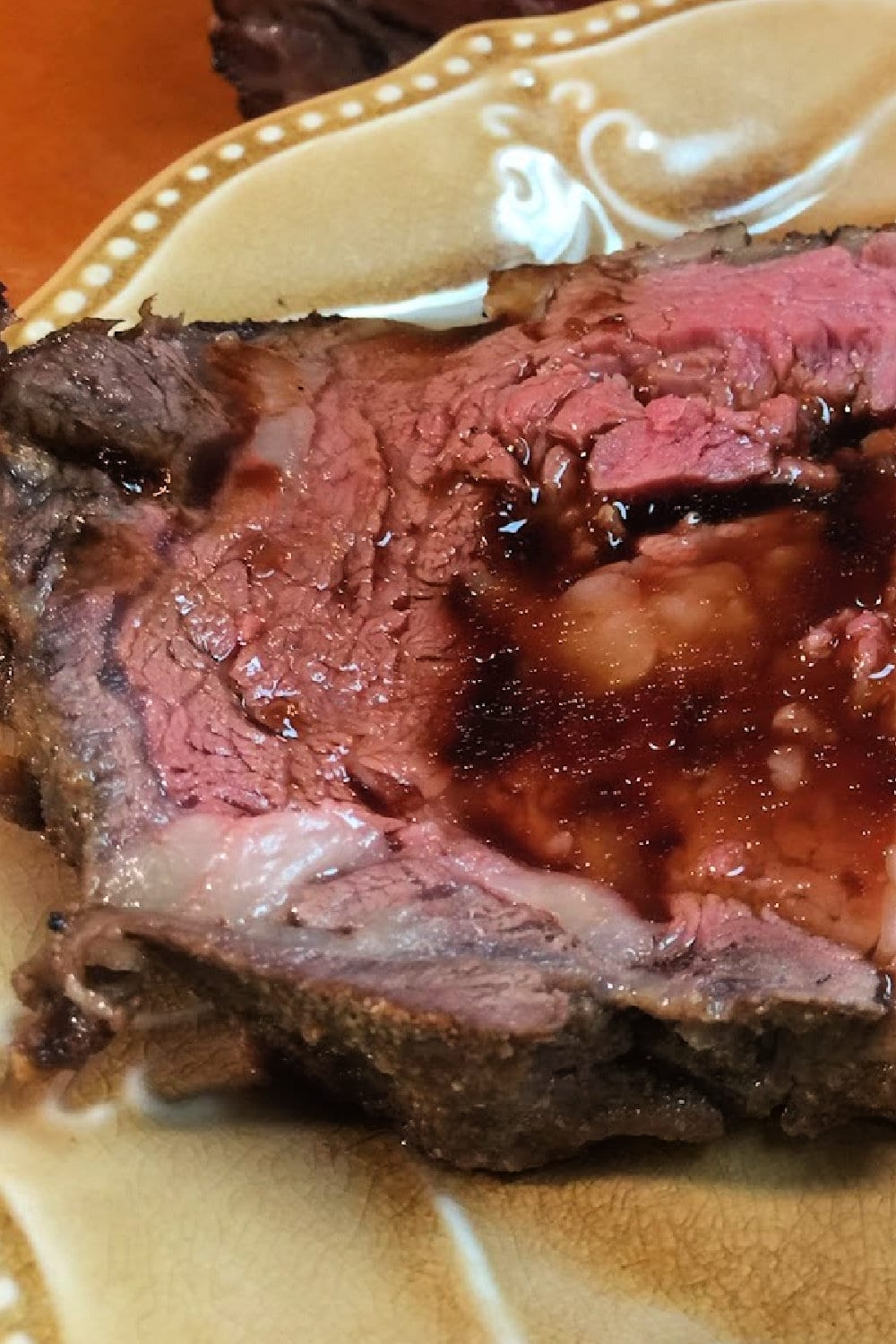


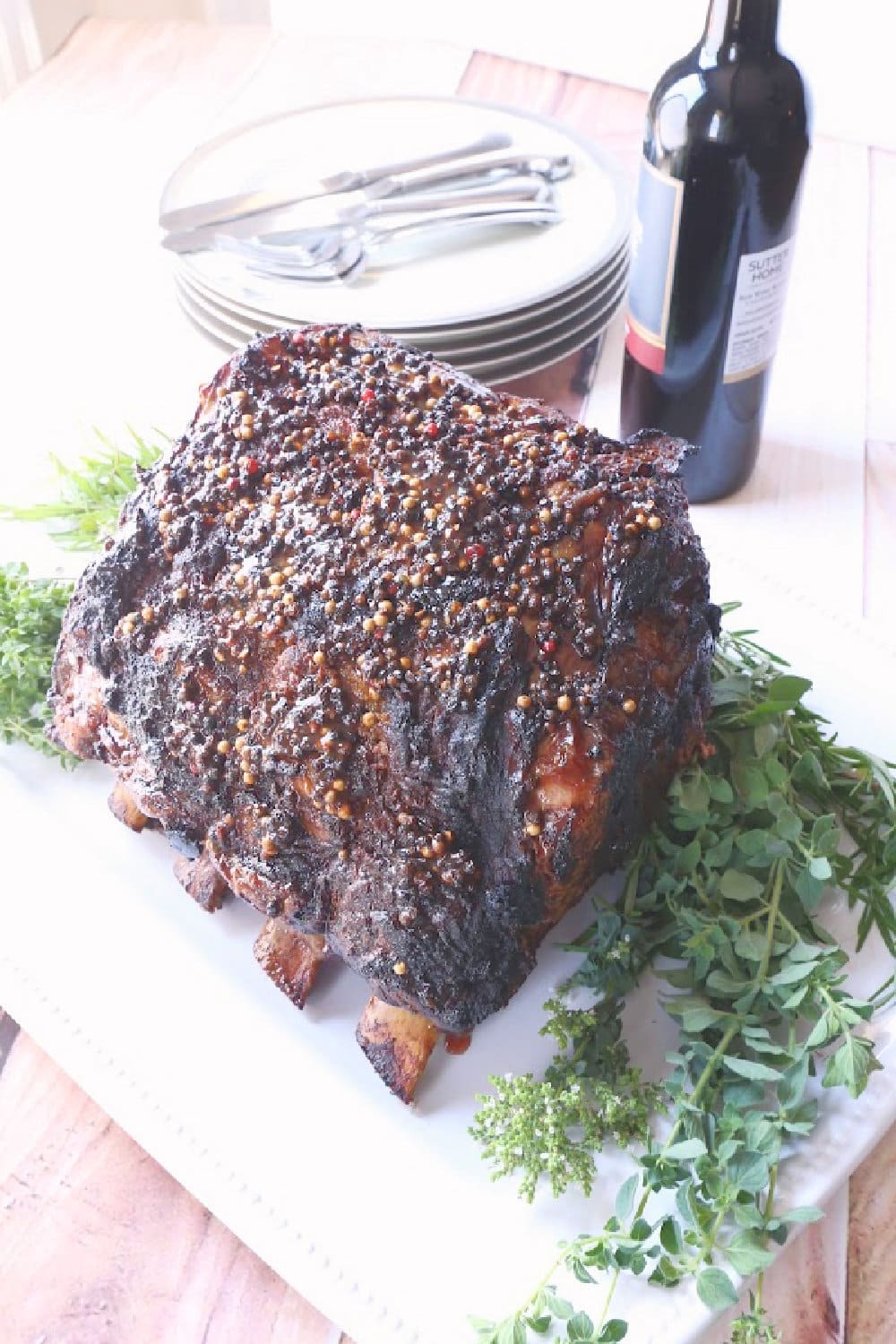

Hi Chef Ali. I’m 77 years old and I’ve never made Prime Rib roast dinner before. Followed your instructions with a 8# prime rib roast and it came out perfect. Will be making this again! Thank You!
Hi Marilyn –
I’m thrilled to learn that your prime rib was a success using this recipe – that makes my heart so happy. That’s a big hunk of beef and it can feel a little intimidating the first time – so glad you conquered! Thank you for taking time to let me know – I very much appreciate it.
Sincerely,
Chef Alli
A question, will this recipe work in an electric roasting pan?
Hi Carol – Forgive me in being so slow to reply to your question – I sincerely apologize. I’ve not tried this method in an electric roasting pan so I cannot say FOR SURE. However, I do feel like it would work and I’m going to test it as soon as I can. If you try it in the meantime, I would sure appreciate the feedback!
Sincerely,
Chef Alli
I follow the recipe exactly and it was perfection
Hi Diana –
I’m thrilled to learn you were successful with my prime rib recipe! Thank yiu for taking time to let me know. I so appreciate it.
Sincerely,
Chef Alli
This is the best, and easiest method to cook a prime rib. I had 5 rib (16 pounds) I did 5 minutes a pound at 500 degrees and lowered oven to 170 for 2 hours. I had a meat thermometer in the roast the entire time which made it so easy to monitor the internal temperature! Thank you!
Hi Tracey –
I’m so glad your prime rib turned out well – this makes me so happy. I want everyone to be successful when cooking meat, so success stories thrill me to death. I think a meat thermometer that stays in the roast throughout the cooking time is a wise investment. That way there’s no question at any point on the exact internal temperature.
Let’s Keep Cookin’,
Chef Alli
Cooked according to directions and my prime rib ended up medium well. So disappointed.
Hi Davielle –
I am so sorry that you didn’t have a good experience with this recipe. I’ve had that happen a time or two in my life and it’s no fun, for sure. I wish I knew exactly what went wrong so I could help you more for next time. Thank you for letting me know your experience.
Sincerely,
Chef Alli
My Rib Roast looked exactly like your
Photographs. It was mouth watering
Perfect. I tried to follow the instructions
Exactly but I didn’t do the math correctly.
When I checked the temperature it registered at 144 degrees which was higher than I actually wanted it. However, I don’t believe it was overcooked at all.
Next time I’ll triple check my roasting time
To reach that 135 degrees. Thanks
Hi there-
Sometimes with cooking, the math just can’t be exact…there are so many variables and often they are out of our hands, try as we might! I’m so glad you caught it and checked the internal temperature before it got too done for your liking. Your guardian angel was looking out for you! Thanks so much for your comment here and the 5 star rating – they are both so appreciated. Please tell you sis hello for me!
Sincerely,
Alli
THIS is my PERFECT prime rib recipe. I have been using it for years. It’s 2023 and I always come back to refresh myself. Complements every time I make it. I do add my own seasonings but nothing else changes.
I see my other review lol. I just want to always leave one whenever I use this recipe because it is so perfect. It’s only a few times a year I make prime rib so hope it’s OK.
Hi Holly – This makes my heart so happy to hear this! Isn’t it great to have a prime rib recipe that we can absolutely COUNT ON?? It brings such relief since meat is such a serious investment!
Thank you for letting me know you value this recipe.
Let’s Keep Cookin’,
Chef Alli
I followed these instructions to the letter today and ruined a very expensive piece of meat. I’m very unhappy. 6 lb roast, 36 min at 500°, turned the oven to the lowest 170°for 2 hours. Meat was 154 when I took it out. RUINED. Don’t recommend these instructions AT ALL.
Hi Jane –
I appreciate you letting me know the experience you had with this recipe and I am sad to learn that it was not a success for you. I know it’s no consolation since the meat is ruined. I wish I could understand what happened since I’ve had so many others who’ve had great success with this method over the years. I suspect that you may have a very very good oven that holds heat better than most and that is why it overcooked, though there’s no way for me to know that for certain. Again, I’m very sorry.
Sincerely,
Chef Alli
Hi Chef Alli, I am curious if you have had anyone report back about cooking 2 roasts at the same time in the same oven. Like Side by side in the same pan. I am wondering if this method is still possible with a huge mass of meat in one oven. I have used this method a couple of time with one roast and it is perfect! Thank you!
Hi Tina –
I have to say that’s I’ve never cooked two prime rib roasts side-by-side in the same oven. I know it could be done, as long as the size of the oven is proportional to the size of both roasts and the space they take up. I would love to know if you were successful in doing this and what adjustments you had to make?
Hope to hear from you,
Chef Alli
If cutting in half ( a 13.5 lb) roast you still cook together in the same oven? Just for half the time?
Hi Paul – Yes! Same process, just adjust the cooking time and you’re golden! Let me know what you think of this recipe.
Sincerely,
Chef Alli
Hi Paul, I am curious how your rib roast turned out. I am purchasing a 7 bone and will have cut in half. I was planning on cooking the 2 roast in the same pan at the same time. Then using the cooking at 500 at the weight of just one of the roasts. Is that what you did? I have used this recipe before with one roast that was about 7.5lbs and it turned out beautiful. I look forward to hearing back from you. Thanks!
Hi Chef Alli, yes I made it. I used the course grind onion powder and it worked just fine. Love your Prime Rib method!!
Thank you.
Wonderful – I felt certain it would be great. Really thrilled you like this method for cooking prime rib – it’s the bees knees.
Let’s Keep Cookin’,
Chef Alli
Hi Chef Ali. I’ve made this Prime Rib before and it’s fabulous!! I’m making it again tomorrow or Sunday. So now I’ve forgotten something. In the rub ingredients, it calls for granulated onion. Can I use California style course grind onion powder with onion and parsley? Thanks.
Hi Pattie –
I’m so sorry that I’m JUST seeing your comment and question on this recipe – forgive me, please. I’m sure it’s too late now, but YES you can totally use the course grind onion powder with parsley – I bet you already did and it was FANTASTIC!
Let me know,
Chef Alli
I was intimidated about this type of roast but OMGosh best recipe ever!
Hi Leslie –
I’m so glad you are pleased with this recipe. Any big hunk of meat can seem intimidating, let along a prime rib roast that’s SUPER expensive…eeek! I’ve found this to be the best method and have never deviated from this recipe since it works so well. Why mess with success?? Thank you for your comment and the 5 star rating – I really appreciate it.
Let’s Keep Cookin’,
Chef Alli